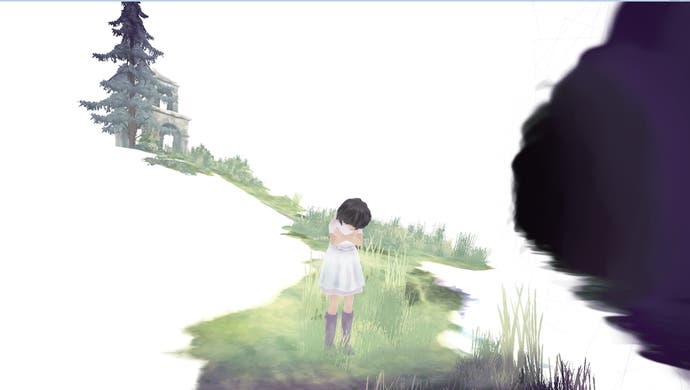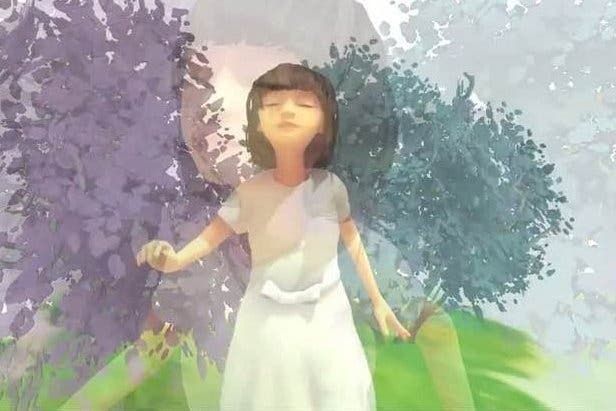Beyond Eyes review
Love is blind.
One summer Rae, a blind girl of around seven years old, strikes up a friendship with a local stray, whom she names Nani. Each day the cat stretches through the bars of an iron gate into Rae's idyllic garden, and the pair plays among the butterflies and daisies. The relationship blossoms, and Rae, for whom no friends come knocking, nor any parent appears to break their routine, comes to rely on Nani for company and comfort. Then, one day, Nani doesn't show up. Rae, who constructs a bright mental image of the world around her entirely by sound and touch, imagining, for example, the whereabouts of a motorcar from the dirty noise of its engine, or a tree from its autumn rustle, decides to head outside of the garden in search of the cat. Beyond Eyes shares, then, a goal with many other video games. It is a rescue mission in the Super Mario tradition, a grand fetch quest, albeit one viewed through a completely unfamiliar lens: disability.
As in Sony's The Unfinished Swan, the form of the world around Rae is hidden beneath a whitewash. A sudden sound in the distance (a crow's craw, a toad's croak) will see the creature momentarily burst into existence on the screen, before fading back to white. In all other cases, the world builds and spreads around Rae only as she moves through it, sensing the difference, for example, between the gravel crunch of a path or the lush bounce of grass underfoot, or that acoustic narrowing that happens when you walk from a field to a tunnel. The environment accumulates in a higgledy, foreign logic. You see the crow before the branch on which he sits. You notice the sheep before the bale of hay that separates you both. Washing flicks on the line and springs into being before you catch the posts on which it's suspended. You see the river long before the bridge that will carry you across its tinkle and froth. Beyond Eyes builds its world like a live watercolour painting. The landscape seeps out around Rae's feet in pastel colours as she plods onwards with cautious determination.

At times, Rae's ears play tricks on her. At first she sees fallen branch, scraping along the road. But when she draws closer, it transmutes into its true form: an umbrella. What Rae perceives to be a car from its idling motor and oily scent, turns out to be a lawnmower, pushed in fussy rows by a gardener. These moments provide constant reminders that, while pretty, the world that you see on the screen is also treacherous. A second sense, usually touch, must be consulted before your mind map can be trusted. Even then, some doubt inevitably remains.
There are few puzzles in the game, principally because simply working out where to go next is often challenge enough. Movement through the world is arduous and sluggish. These ponderous animations and seemingly listless controls are, arguably, a function of the fact that Rae is worried she might smack into a wall or fall from a ledge at any moment. But they are nevertheless laborious. Rae chooses not to run, and, as you cannot perceive the world's fence and bush borders till you are adjacent to them, you can often spend a minute walking in what you think is the correct direction, only to have to retrace your steps. Mercifully, once you've filled in the blanks, the landscape remains in place (it doesn't fade away, as you press on) - at least, until it begins to rain later in the game, and the sound of the raindrops wipes away your mind-map, making exploration even more exhausting and somehow unfair.
The results may be abstractly authentic. After walking a mile in Rae's shoes, you emerge with what feels like a truer understanding of what it must be like to wander unfamiliar countryside without sight, or guide. But the game couldn't be described as an enjoyable experience. It may offer a whimsical tribute to the power and companionship of pets, and a powerful insight into the specific anxieties of a blind person in an alien place, but the story of your journey to this conclusion is nevertheless bland and uninspired. Where the game offers the whisper of a puzzle (at one point you have to lure a gang of seagulls from a path in order to progress by finding them food, for example), the designers attempt to mask its straightforwardness simply by sending you on a tortuous route.
Rae, in white-dress with a bow for a buckle and mauve Wellington boots, is delightful, if a little twee - a 19th century-esque exaggeration of an adorable child. She encounters the world around her with enviable joy (she giggles at a frog, exclaims an 'ah!' when knocking her shins into a branch, and even manages to tempt butterflies to follow her around). Her amiability coupled with her disability makes criticising the game in which she stars seem cruel and churlish. And this is, at very least, an interesting project, that will, perhaps, leave players with a better understanding of what it feels to journey without sight. But it is, alas, less worthwhile than it is worthy.

